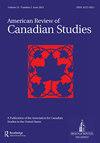晚年无家可归:弱势和不平等老龄化的经历
IF 0.4
Q3 AREA STUDIES
引用次数: 0
摘要
他们的起源早于他们的社区的建立。正如r本文章由计算机程序翻译,如有差异,请以英文原文为准。
Late-Life Homelessness: Experiences of Disadvantage and Unequal Aging
with origins that predated the creation of their community. As Rück has stated, The Laws and the Land examines primarily the actions committed on an Indigenous community by the state instead of presenting these relationships as Indigenous history. While the author begins with a focus on settler colonialism, he gradually reveals his work is much more than a micro example of colonization on the outskirts of one of Canada’s largest cities. Kahnawa’kehró:non did not simply respond to these enormous pressures, they innovatively made decisions to protect their community and minimized the harm. Kahnawà:ke law may have been the basis of this resistance, but new ideas emerged from dire situations. While settler colonialism is a popular approach to Indigenous history, it should be asked if there is a danger in over emphasizing its strength. It seems that Kahnawà:ke experienced a higher degree of settler colonialism than its neighbors. Other reserves in the valley surely had similar challenges, but by the nineteenth century, Kahnawà:ke’s location—once prized for trade and alliance formation—was on the front lines of industrialization that could not be stopped. Rück knows the invasion of the setter state of Canada that he so carefully lays out caused considerable harm to Indigenous people, and it continues to do so. He values forging positive relationships with Indigenous community members, and these personable connections have not only changed him as a scholar, but also reveal the benefits they produce in writing about Indigenous communities. While some readers may hesitate with the author’s movement toward a declension narrative, Rück truly makes us appreciate the significant obstacles that Kahnawa’kehró:non confronted to protect their land base and assert their own laws.
求助全文
通过发布文献求助,成功后即可免费获取论文全文。
去求助
来源期刊

American Review of Canadian Studies
AREA STUDIES-
CiteScore
0.60
自引率
0.00%
发文量
25
期刊介绍:
American Nineteenth Century History is a peer-reviewed, transatlantic journal devoted to the history of the United States during the long nineteenth century. It welcomes contributions on themes and topics relating to America in this period: slavery, race and ethnicity, the Civil War and Reconstruction, military history, American nationalism, urban history, immigration and ethnicity, western history, the history of women, gender studies, African Americans and Native Americans, cultural studies and comparative pieces. In addition to articles based on original research, historiographical pieces, reassessments of historical controversies, and reappraisals of prominent events or individuals are welcome. Special issues devoted to a particular theme or topic will also be considered.
 求助内容:
求助内容: 应助结果提醒方式:
应助结果提醒方式:


